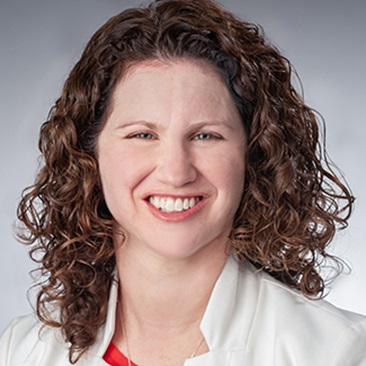‘An Incredible Endeavor’
June 15, 2022
In Harriet Tubman’s bicentennial year, alumni and faculty reflect on their role preserving her legacy and take stock of new milestones, including a national park designation, a book and the $20 bill.
By Jessica Youngman
Archaeologist Jessica Bowes uncovers clues about the past underground, but on this spring day, something sitting atop the soil outside Harriet Tubman’s house catches her eye.
It’s a small piece of glass next to the front porch. Even though it’s highlighted by the morning sun, most would have missed it. Bowes’ eyes are trained to the ground, always searching, it seems, for a piece of the past. Clad in her grey and green National Park Service uniform, Bowes crouches down and collects the piece of glass and another she spots nearby. She slowly turns them in her hands, pointing out their differences. One is thick and curved, likely from an old bottle, she explains. The other is thin and flat—probably from a broken window.
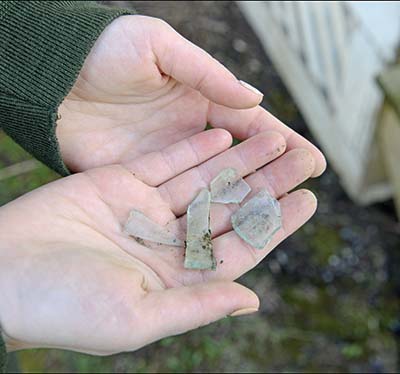
Once buried, these pieces of glass were pushed to the surface by natural nudges—things like rain, tree roots and the movement of small animals and insects. It’s a process called bioturbation, Bowes says, which makes such finds nearly impossible to date and archaeologically insignificant.
“These could have been from 1950 or 1850,” says Bowes. “They could have been brought here as part of a load of fill dirt a few decades ago, or, they may have come from Tubman’s household.”
The possibility of the latter makes every find at the Harriet Tubman Home exciting—even for Bowes. She’s a Maxwell School graduate student and the newly minted cultural resource specialist for the site, which was recently designated the Harriet Tubman National Historical Park.
Located in Auburn, New York, the 25-acre property is where Tubman laid roots after self-emancipation, continuing her mission to care for the African American community and support the suffragist movement. It consists of a two-story brick home that served as her family’s residence, a barn, a white clapboard house that was part of her Home for the Aged, and a visitor’s center.
Each year, it draws thousands of tourists, ranging from elementary school groups and families to elected officials and, one day this past March, Grammy-winning musician Alicia Keys. An uptick in visitors is expected this year, as it’s the bicentennial of Tubman’s birth in 1822, and interest in her story has piqued with the social reckoning of recent years.
Those who take the tour may not notice pieces of glass resting on the soil, but they will see displays containing artifacts—toy figurines, teacups and more—that were unearthed by Maxwell students, including Bowes, who took part in an archaeology field study that was offered at the site for nearly 20 years.
Visitors will also hear details of Tubman’s life in freedom that would not have been known if not for the work of those students under the guidance of Maxwell anthropology Professor Douglas Armstrong, who is about to release a new book, The Archaeology of Harriet Tubman’s Life in Freedom (Syracuse University Press, 2022).
Though the archaeology course was last offered several years ago, Maxwell’s connection to the Tubman site endures. It’s evidenced by Bowes, who has come full circle with what she calls her “dream job,” and with other alumni of the program who say their findings at the site changed their perspective and, in some cases, inspired careers.
“We were part of an incredible endeavor. It was like a time machine: You’re handling artifacts that were part of the house and household of her family and close friends.”
Christine Ames ’10 B.A. (Anth)
Hidden in Wild Roses
Maxwell’s connection came about by happenstance.
In the early 1990s, as part of a public policy and archaeology class, Professor Douglas Armstrong and his undergraduate students carried out an investigation of the former Wesleyan Methodist Church in Syracuse, where several sculpted clay faces were found in the basement.
The pieces of art may have been made by African American refugees from slavery. As part of a follow-up summer field school, Armstrong and his students visited several sites tied to abolition.
The Harriet Tubman Home was one of their stops. Armstrong remembers that, early in the visit, he took note of a photo on display in the visitor’s center that showed a large brick building named John Brown Hall, which had served as a dormitory or infirmary for Tubman’s Home for the Aged. Rev. Paul Carter, the site’s longtime caretaker, told the professor that the building had been torn down long before, its remains lost somewhere in the woods out back.
It was lunchtime. Armstrong’s students were hungry. He told them they could eat—after they found the building’s remains. “Within 15 minutes we found the basement of John Brown Hall, hidden in wild roses and berry bushes,” recalls Armstrong.
The mood was jovial, but privately, Armstrong was surprised by the condition of the property. He would later come to understand that its owners, the A.M.E. Zion Church, had done their best through the years to protect the site but struggled with few resources and little support.
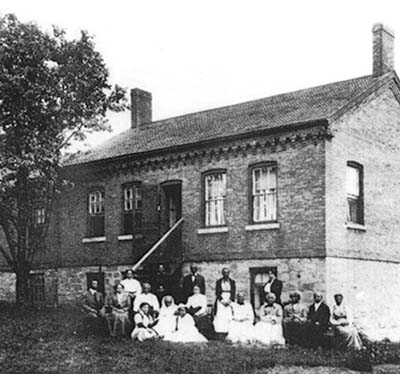
Armstrong asked Carter if he could return for an archaeological project. “His eyes lit up,” recalls Armstrong. “He wanted people to love this place like he did. That excitement, it got to me. I said, ‘I’m going to do this.’”
Armstrong returned to the site in the summer of 1999 to teach a month-long field school course. The first of an annual offering at the site for undergraduate and graduate students, it drew a mix of anthropology majors and others looking to fulfill a social sciences requirement.
The first two summers were spent excavating around John Brown Hall. They recovered rings, broaches and picture frames, as well as an array of medicine bottles and ointment jars.
The team later expanded their work across the property, excavating a tremendous collection of material objects.
In the summer of 2002, they found the equivalent of an archaeological jackpot alongside Tubman’s brick house. “About six inches below the surface, we started finding ash,” says Armstrong. “Then we started noticing burned artifacts.”
They had been looking for the remains of a garden but instead discovered a builder’s trench that contained debris and contents from the brick home’s predecessor—a wooden structure shown in early photos. Armstrong wondered what necessitated the rebuild; he and others assumed the first structure was destroyed by fire but, until now, had no evidence.
One of the first items pulled from the trench was part of a cup that included maker’s marks traced back to the former Onondaga Pottery Co., sometime between 1875 and 1882. “No one really knew what happened to the house,” says Armstrong. “Using the timeframe of the pottery, we went into newspaper records and found at least two accounts of a fire on Feb. 10, 1880, and it all made sense.”
Elsewhere on the property, Armstrong and the students also uncovered a brick kiln. After reviewing historic records, they came to believe that the bricks for the new home were made on site under the supervision of Tubman’s second husband, Nelson Davis.
Students also unearthed ornately patterned tea sets that were likely used for important social functions. Tubman was known to have both hosted and attended teas with other leading suffragists and activists of the time including Lucretia Mott. But her gatherings were unconventional by comparison: “She invited men and women and she didn’t have racial distinctions,” says Armstrong. “They didn’t just drink tea, they engaged in discourse—this was a means by which Tubman tried to achieve her goals.”
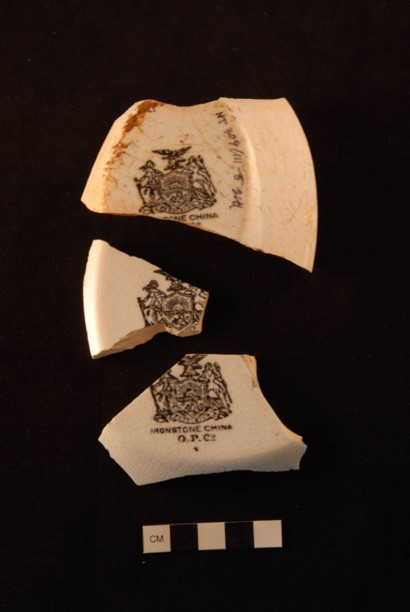
Armstrong’s colleague, Carol Faulkner, professor of history and associate dean for academic affairs, praises his groundbreaking research into Tubman’s postwar life and activism. “Tubman and Mott were part of a network of activists who deliberately built a movement against racism as well as slavery,” she says. “It is important to remember that this anti-racist organizing persisted into the post-Civil War era.”
Jessica Bowes, the doctoral student and National Park Service employee, says even the simplest of finds are exciting—a clay marble buried along the former walkway or a piece of glass. “Once you find one, you think to your- self, ‘I’m the first one to touch this since Tubman’s household used this.’ Being able to be part of Tubman’s legacy is life-changing in many ways,” she said.
Alumnus Curt Coville ’20 B.A. (Anth) took the course in 2013 while working toward his undergraduate degree as an adult student. “I remember one of the coolest things I discovered was a pre-Civil War New York militia button,” he says.
Christine Ames ’10 B.A. (Anth) remembers finding nails, an ornate bone-handled toothbrush, parts of a toiletry kit and bits of leather from a shoe. “We were part of an incredible endeavor,” she says. “It was like a time machine: You’re handling artifacts that were part of the house and household of her family and close friends. I think it’s incredible that archaeology has been able to play a large role in continuing to tell the story of her life, which after the Civil War, was no less extraordinary.”
A Peek into Tubman’s Life
Most weekdays at the Harriet Tubman Home start with a 10 a.m. tour by site manager, Rev. Paul Carter. On a recent Wednesday, he’s greeted by two young families who’ve reserved the slot in advance.
After providing a brief overview of Tubman’s life, Carter walks them from the visitor’s center toward the white clapboard house. Amplified by a portable headset microphone, he explains that the structure was central to her efforts to provide care for the sick and elderly. The house was previously believed to have been Tubman’s living quarters—in their research, Maxwell Professor Douglas Armstrong and students helped dispel that and many other previously held assumptions.
As Jessica Bowes walks past, Carter pauses the tour and calls on her to introduce herself. After a sheepish pause, Bowes shares that she’s just started a new post with the National Park Service; in addition to the Tubman site, she works for the Women’s Rights National Historical Park in nearby Seneca Falls. Carter elaborates that she was among the Syracuse University students who excavated roughly 70,000 artifacts from the property. Though their faces were partially obscured by masks—a sign of the times—the visitors’ astonishment was clear.
Bowes enrolled in the Maxwell School to pursue a doctorate in anthropology in 2009—about 10 years after the summer field study had begun. Her master’s degree research at the University of Massachusetts, Boston, had focused on an enslaved community in Virginia.
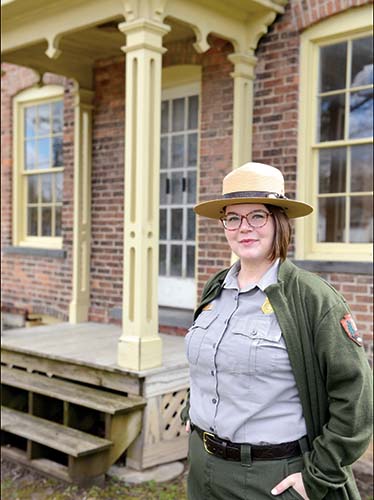
“I was drawn to Syracuse because it has strong researchers in that area,” says Bowes. Armstrong was among them. For decades, he has explored issues related to African diaspora, slavery and freedom with a focus on archaeological investigations in the Caribbean.
Bowes spent six summers conducting research at the Tubman site, most recently in 2015 as a teaching assistant. Her doctoral work, temporarily on hold while she gains footing in her new position, explores the relation- ship between Tubman’s household and food and identity in Auburn.
“That research is a balance of using the data and going back to the traditions of the people we know about,” she says. “I am trying to learn what foods those in Tubman’s household ate while living in Auburn and better understand their relationship to those foods. Tubman, and those in her home, were both and their food choices and tastes reflect their whole lived experience and weren’t necessarily defined by their legal status.”
Amid her field study work, in 2012, Bowes took a position as an archaeology technician at Fort Stanwix National Monument in Rome, New York. Six years later, she was offered an opportunity to serve as one of two national park rangers at the Tubman property. She spent four months assisting Carter with operations and tours. She helped coordinate special events, developed new programming and built partnerships with organizations like the Girl Scouts.
“It was a really great experience,” she says. “That gave me a breadth of historical context for the site, and it gave me experience in being public facing.”
Alumna Christine Ames shares the sentiment. She’s now an assistant city archaeologist for Washington, D.C. The position is situated in the city’s historic preservation office, which serves as a reviewing agency for proposed development projects, leads educational outreach programs and manages a vast archaeology collection.
Ames says the public-private partnerships that have helped protect and advance the mission of the Tubman site have provided a powerful model for her current work, which often crosses sectors. In particular, she has admired the relationship between the National Park Service and the Harriet Tubman Home’s longtime owners, the A.M.E. Zion Church. Tubman bequeathed the property to the church in 1903, 10 years before her death. In a unique arrangement, the church continues to own and operate the site under a nonprofit designation in partnership with the Park Service.
“I also really took note of the support network that was in place and how important community engagement was for archaeology,” says Ames. “This is one of the les- sons I learned at Maxwell that has really stuck with me. If anything, Dr. Armstrong and the A.M.E. Zion church made it all look easy but having had my own professional experiences these past few years, I really respect and appreciate the fact that it is a lot of work, and it is hard work—but it’s so important.”
Even though he didn’t wind up in the profession, alumnus Curt Coville says the field study was transformative.
“I was not a strong student when I was younger but through experiences like this, I began to flourish as a learner,” he says. “Having the opportunity to learn history through these unique hands-on experiences was one of the reasons I wanted to go on. Learning about Harriet and her history has stuck with me.”
Coville went on to earn a master’s in education and is now pursing an MBA at the Martin J. Whitman School of Management. He works not far from the Tubman home, for a nonprofit called Cayuga Centers that supports foster children. He says his work embraces “the spirit of Harriet Tubman.” Inspired by her legacy, he adds, “I hope to continue doing as much good as I can.”
Metal Buttons
Preservation efforts at the Harriet Tubman Home in recent years have included the addition of two historically accurate porches to the brick home, along with new windows that were painstakingly handmade to replicate those from the 19th century.
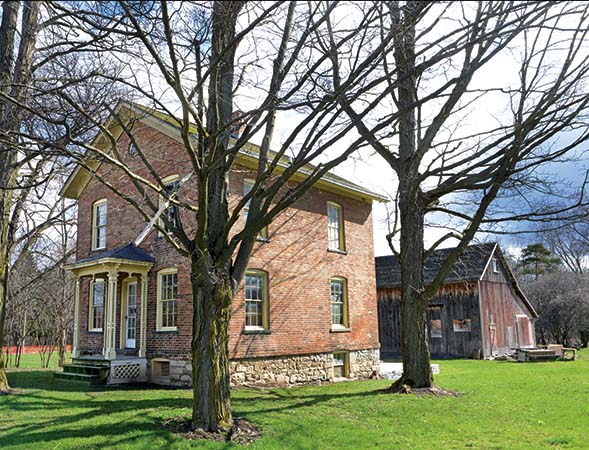
In addition, a wooden barn has been constructed behind the house using what could be salvaged from the original structure, which was damaged through the decades by weather and conversions made by well- meaning tenants.
The partnership with the National Park Service, which became official in January 2017, may allow for new opportunities.
In the lead up to the property’s designation as the Harriet Tubman National Historical Park, Professor Doug- las Armstrong made a half-dozen trips to Washington, D.C., joined by A.M.E. Zion Church representatives and Karen Hill, president and CEO of the Harriet Tubman Home, Inc. They met with lawmakers and found support on both sides of the aisle, including former senator and first lady Hillary Clinton, U.S. Sens. Charles Schumer and Kirsten Gillibrand, U.S. Rep. John Katko and former U.S. Rep. Dan Maffei.
Armstrong, Hill and others returned to D.C. for a signing ceremony. During the trip, he toured the Smithsonian alongside Tubman’s grandnieces, who he’d come to know through the years while excavating the property.
More recently, in 2019, Armstrong brought a group of Maxwell students to conduct a research project at the church and parsonage for what’s now called the Thompson Memorial A.M.E. Zion Church. Owned by the National Park Service, it is located a few blocks from the Tubman home and is where her funeral was held in 1913. Students uncovered curbstone dating back to Tubman’s time, as well as serving dishes and materials used for the original construction.
Around the same time, Armstrong was invited to Auburn to attend a pre-screening of the feature film “Harriet.” The audience also included many of his friends from the Harriet Tubman Home and Tubman descendants. “They were extremely happy with the film,” he recalls.
He was pleased, too. The biographical film ends before the Civil War, leaving the story of Tubman’s time in Auburn untold. It was an affirmation to Armstrong of the importance of another project he’d been immersed in behind the scenes—at the time of the premiere, he’d just finished a draft of his book, The Archaeology of Harriet Tubman’s Life in Freedom.
The book was to be released in 2021, but as with so many other things, COVID caused delays that pushed its publication to this year. The lag may have been serendipitous, as the release now coincides with Tubman’s bicentennial, an occasion that is being marked by special events in Auburn and across the country.
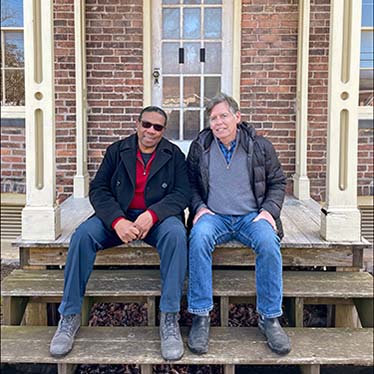
In recent years, Armstrong has also been involved with efforts to use Tubman’s image on the $20 bill. He was among the historians and archaeologists asked to provide input to an artist who was commissioned to create a portrait for eventual use on the currency.
During one of his trips to Washington, D.C., Armstrong was invited to view the resulting artwork. He was pleased to see a suggestion he’d made to the artist had made it onto the painting: three, six-pointed metal star buttons pinned to Tubman’s dress. Armstrong and his Maxwell students routinely found the buttons in the ground on her Auburn property.
“We thought it was a magnificent painting,” he says. “The image may change, but if they make it onto the final $20 bill, Maxwell will forever have that connection.”
RELATED STORY: Basketball Legend John Wallace '12 B.A. (Soc) Says Tubman Field Study was an 'Awesome Experience'
Published in the Summer 2022 issue of the Maxwell Perspective
Related News
School News
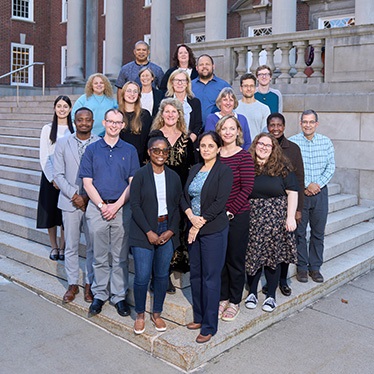
Dec 5, 2025
School News
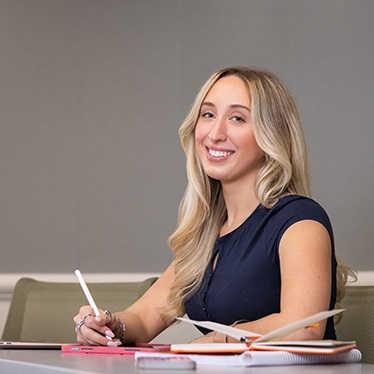
Dec 4, 2025

